Vettersfelde Treasure
Autor Goran Pavlovic © © tłumaczenie i komentarz Czesław Białczyński
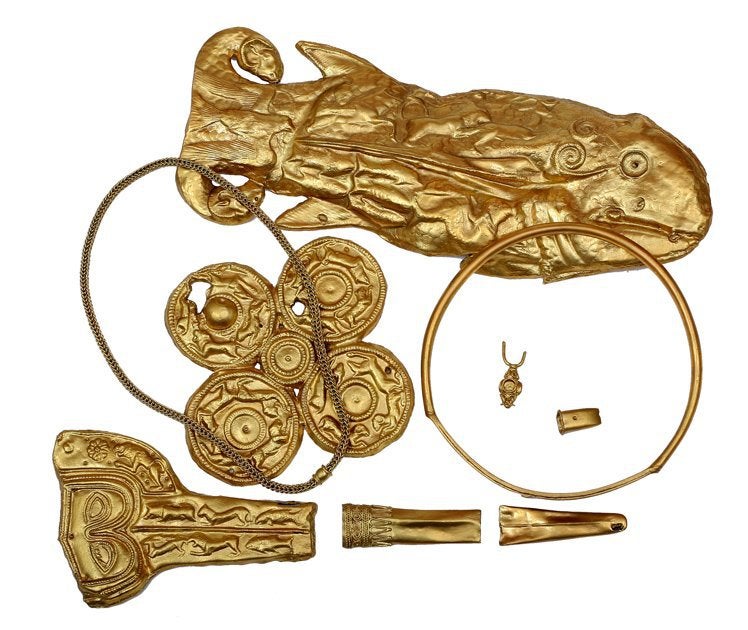
Skarb z Witaszkowa
The Vettersfelde Treasure is a treasure trove of gold objects, which was found by chance in what was then Vettersfelde in the Province of Brandenburg (modern Witaszkowo, near Gubin, Poland) in 1882. The treasure is now in the Antikensammlung Berlin…
Skarb z Vettersfelde to skarbnica złotych przedmiotów, która została przypadkowo odnaleziona w 1882 r. na terenie ówczesnego Vettersfelde w Brandenburgii (dzisiejsze Witaszkowo, niedaleko Gubina). Skarb znajduje się obecnie w Antikensammlung Berlin…
The main objects in the trove are: a fish shaped plaque, four discs plaque, and a cover of a dagger sheath. All these objects are dated to the early 6th century BC, are decorated in the steppe „animal style”, and are believed to be „of Scythian origin”…
Głównymi przedmiotami w skarbcu są: tabliczka w kształcie ryby, tablica z czterema dyskami oraz osłona pochwy sztyletu. Wszystkie te obiekty datowane są na początek VI wieku p.n.e., są udekorowane w stepowym „stylu zwierzęcym” i uważane są za „pochodzenia scytyjskiego”…
How they ended up in the North Poland is still debated. Original theory was that during a Scythian expedition into central Europe, a Scythian prince died and was buried near Brandenburg with the trove forming part of his grave-offerings. But this is today disputed…
To, jak znalazły się te przedmioty w północnej Polsce, jest nadal przedmiotem dyskusji. Pierwotna teoria głosiła, że podczas wyprawy scytyjskiej do środkowej Europy zmarł scytyjski książę i został pochowany w pobliżu Witaszkowa wraz ze znaleziskiem będącym częścią jego ofiar grobowych. Ale dziś jest to kwestionowane…
As interesting as the origin of the hoard is, I find what is depicted on the objects more interesting…From the point of view of animal calendar markers and their presence in Scythian (???) culture…
O ile ciekawe jest pochodzenie skarbu, to bardziej interesujące jest dla mnie to, co jest przedstawione na przedmiotach… Z punktu widzenia znaczników kalendarza zwierząt i ich obecności w kulturze scytyjskiej (???)…
I already talked about the presence of animal calendar markers in the steppe „animal style” decorated objects in two previous articles.
O obecności znaczników kalendarzy zwierzęcych w stepowych obiektach dekorowanych „zwierzęcym stylem” mówiłem już w dwóch poprzednich artykułach.
In my article about „Combs from Tuva”
W moim artykule o „grzebieniach z Tuwy”
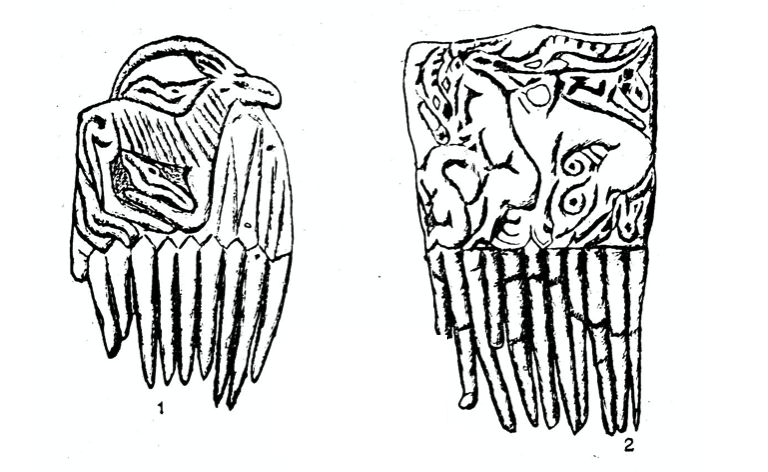
And in my article about „Tasmola talisman”
I w moim artykule o „Talizmanie Tasmola”
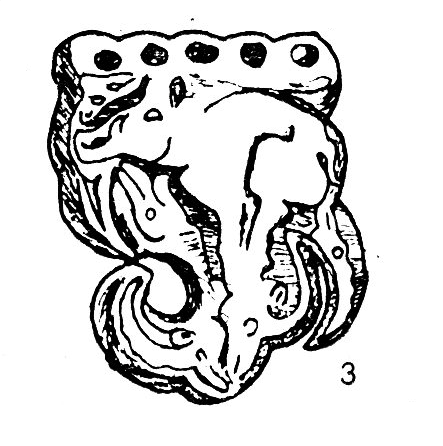
In them I showed that that animals used were not depicted together randomly. Rather, the animals that are depicted together, are the animal calendar markers, used to mark the same part of the year…
Pokazałem w nich, że użyte zwierzęta nie były przedstawiane razem losowo. Zwierzęta, które tam są przedstawione razem, są raczej znacznikami kalendarza zwierząt, używanymi do oznaczania tej samej części roku…
In the paper „Der Goldfund von Vettersfelde” (in German) we can find high definition drawings of the objects from the Vettersfelde Treasure which allow us to see precisely what animals are depicted on them…
W artykule „Der Goldfund von Vettersfelde” (po niemiecku) możemy znaleźć rysunki przedmiotów ze Skarbu Vettersfelde w wysokiej rozdzielczości, które pozwalają nam dokładnie zobaczyć, jakie zwierzęta są na nich przedstawione…
In the rest of this article I will analyze the scenes depicted on these objects and will try to explain why they were decorated the way they were…
The cover the of the dagger sheath.
W dalszej części tego artykułu przeanalizuję sceny przedstawione na tych przedmiotach i postaram się wyjaśnić, dlaczego zostały one udekorowane tak, jak zostały…
Osłona pochwy sztyletu.

On top we can see a lion chasing the sun. Lion is primarily symbol of autumn (Aug,Sep,Oct) because this is when the main Eurasian lion’s mating season takes place. This is what Leo marks 🙂. Start of lion mating season.
Na górze widzimy lwa goniącego słońce. Lew jest przede wszystkim symbolem jesieni (sierpień, wrzesień, październik), ponieważ to właśnie wtedy odbywa się główny sezon godowy lwa euroazjatyckiego. To właśnie oznacza Leo 🙂. Początek sezonu godowego lwów.
[Lew jest jednak znakiem przełomu LIPCA (od 20 07) oraz SIERPNIA (do 21 08) CB, w związku z czym – kto wie??? to naprawdę śmiałą hipoteza jaka teraz wypowiem, ale być może chodzi tutaj o lwy europejskie z późnej epoki kamienia??? CB]
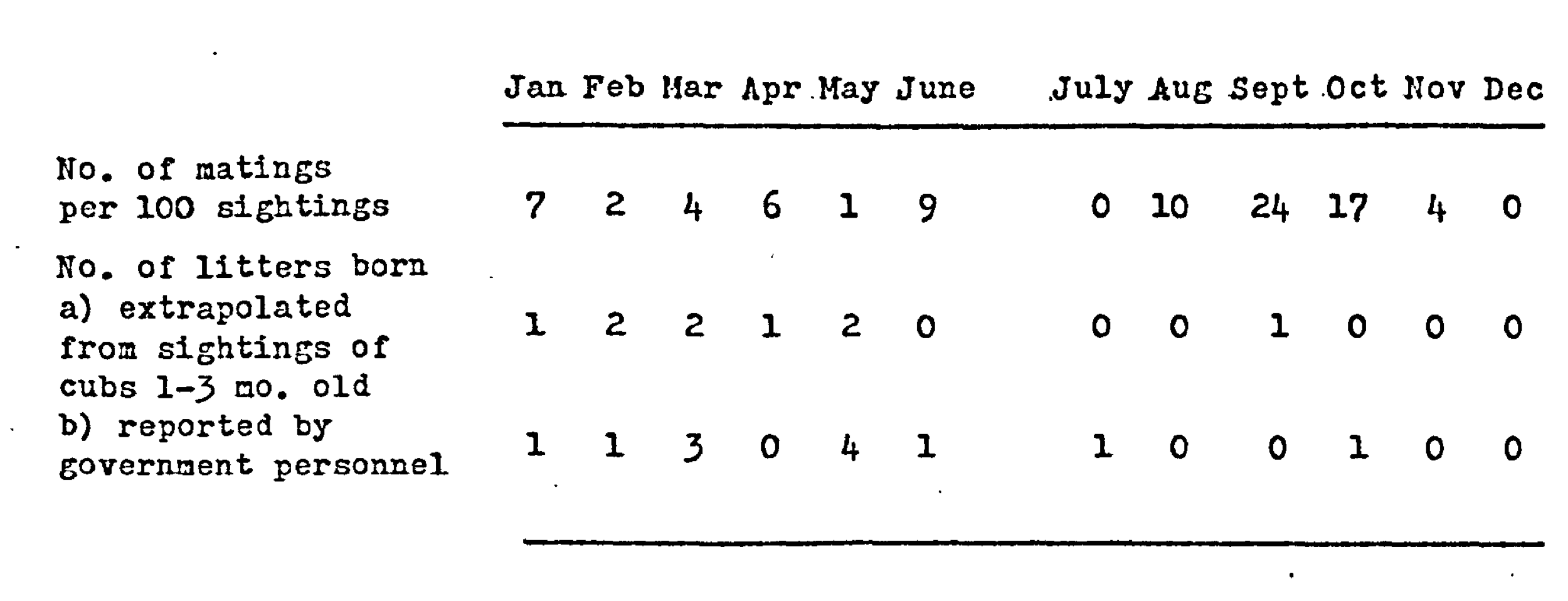
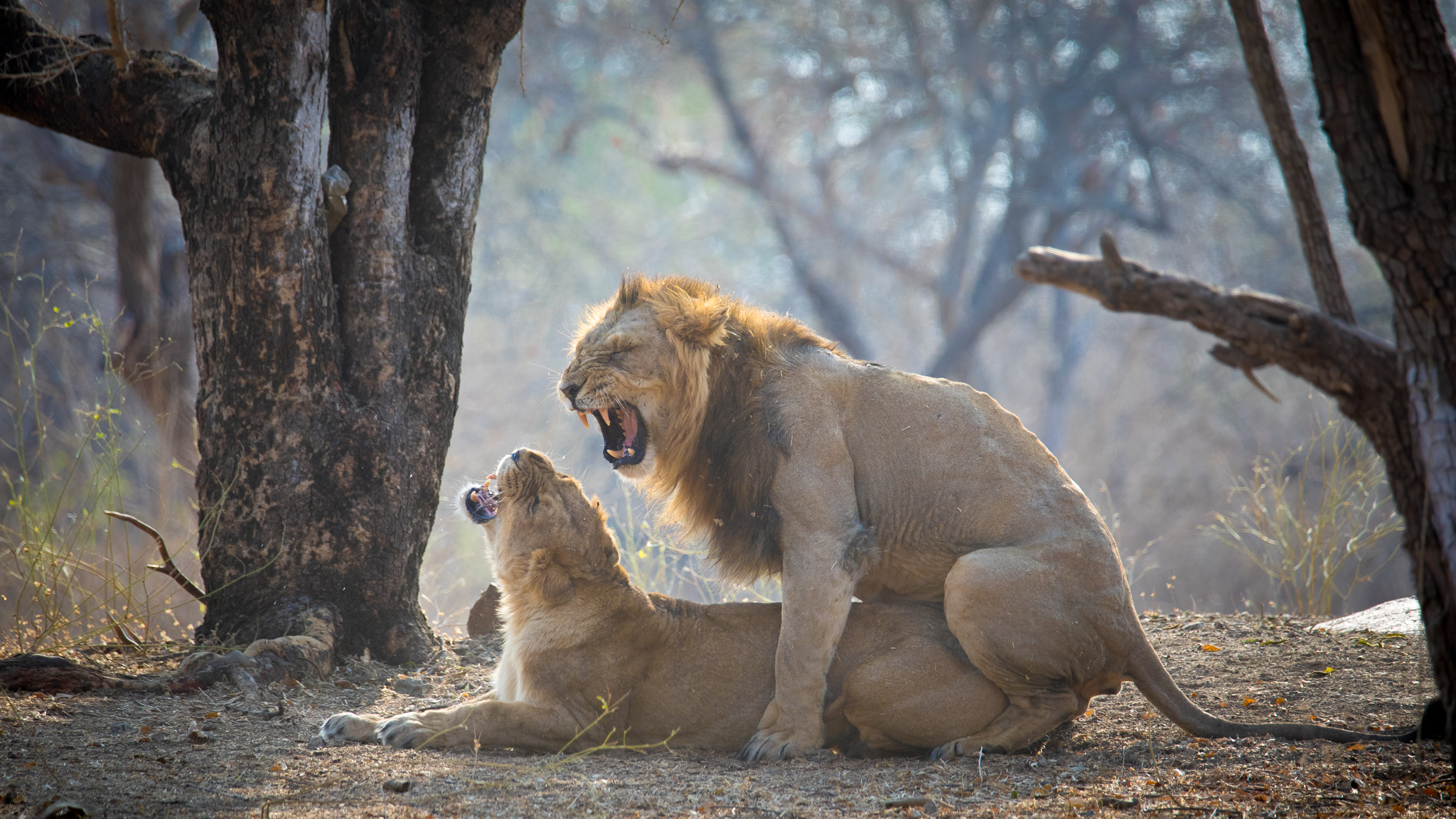
But lion is also used to represent the whole hot dry part of the year. Leo marks the hottest and driest part of the year in continental northern Eurasia…I talked about this in this article „Mycenaean ostrich egg with seasons” where I talked about this beautiful Mycenaean engraved ostrich shell

Below the lion chasing sun, in the top strip, we see a wild boar (mating season, beginning of winter, Nov/Dec/Jan) being chased by a Eurasian leopard (mating season, end of winter, Jan/Feb). So the top strip symbolises winter…
Poniżej lwa goniącego słońce, w górnym pasie widzimy dzika (okres godowy, początek zimy, listopad/grudzień/styczeń) ściganego przez lamparta euroazjatyckiego (okres godowy, koniec zimy, styczeń/luty). Tak więc górny pasek symbolizuje zimę…
[CB i znów – może to nie lampart ale ryś europejski, albo pradawny lampart europejski znad Dunaju i Morza Czarnego???]

I talked about boar as a symbol for the beginning of winter, and winter itself, in my posts „Tasmola talisman„,”Calydonian boar„, „Double headed eagle„, „Overpowering„…
O dziku jako symbolu początku zimy i samej zimie mówiłem w moich postach „Talizman tasmoli”, „Dzik kalydoński”, „Orzeł dwugłowy”, „Obezwładniający”…
I talked about leopard as a symbol for the end of winter, and winter itself, in my posts „Leopard and tiger„, „Furious Maenad„, „Spots and stripes„, „Two headed dragon„, „Griffin killing lizard„, „Vessel from Tepe Hissar„…
O lampartach jako o symbolu końca zimy i samej zimie mówiłem w swoich postach „Lampart i tygrys”, „Wściekły menada”, „Plamy i paski”, „Dwugłowy smok”, „Gryf zabija jaszczurkę”, „ Statek z Tepe Hissar”…
Below that, in the bottom strip, we see a Persian fallow deer (mating season, autumn, Aug/Sep) being chased by an Eurasian lion (mating season, autumn, Aug/Sep/Oct). So the bottom strip symbolises autumn…
Poniżej, w dolnym pasie, widzimy perskiego daniela (okres godowy, jesień, sierpień/wrzesień) gonionego przez lwa euroazjatyckiego (okres godowy, jesień, sierpień/wrz/październik). Tak więc dolny pasek symbolizuje jesień…
[CB – a może to europejski jeleń??? I znów europejski lew??? – Toi cofnęłoby powstanie kalendarza w czasy Łowców Mamutów i przeniosło go nad Dunaj! Wiem, że to bezczelnie odważna, „szaleńcza” hipoteza…]
I talked about deer as a symbol for autumn in my posts „Mycenaean ostrich egg with seasons„, „Queen Puabi’s cylinder seal„, „Entemena Vase„, „Upside down„…
O jeleniu jako symbolu jesieni mówiłem w moich postach „Jajo strusia mykeńskiego z porami roku”, „Pieczęć cylindryczna królowej Puabi”, „Waza Entemena”, „Do góry nogami”…
I talked about lion as the symbol for the beginning of autumn (Jul/Aug) the hottest time of the year, and for autumn itself in my posts „Mycenaean ostrich egg with seasons„, „Musth„, „Lions vs buffalos„, „Summer and winter seal„, „Winged superhuman hero„…
Mówiłem o lwie jako symbolu początku jesieni (lip/sierpień), najgorętszej porze roku i samej jesieni w moich postach „Jajo strusia mykeńskiego z porami roku”, „Musz”, „Lwy kontra bawoły”, „ Foka letnia i zimowa”, „Skrzydlaty bohater nadludzki”…
Interestingly, the mating seasons of wild boar and Eurasian leopards overlap at the end of winter, the coldest part of the year. While the mating seasons of the Persian fallow deer and Eurasian lions overlaps at the beginning of autumn, the hottest part of the year…
Co ciekawe, okresy godowe dzików i lampartów euroazjatyckich nakładają się pod koniec zimy, najzimniejszej części roku. Podczas gdy okresy godowe danieli perskich i lwów euroazjatyckich pokrywają się na początku jesieni, najgorętsza część roku…
[A jednak gdy przyjmiemy perspektywę europejską, naddunajską z epoki łowców to niekoniecznie muszą sie pokrywać, mogą się różnić od siebie np o jeden miesiąc, a przez to wyrażać do0kładniejszy znacznik kalendarzowy – dokładnie mięsieczny. CB]
So it is possible that these two scenes actually depict the two „old” seasons: summer (Apr/May-Oct/Nov) and winter (Oct/Nov-Apr-May) with coldest part (Leopard) and Hottest part (Lion)
Możliwe więc, że te dwie sceny faktycznie przedstawiają dwie „stare” pory roku: lato (kwiecień/maj-październik/listopad) i zimę (październik/listopad-kwiecień-maj) z najzimniejszą częścią (Lampart) i Najgorętszą częścią (Lew).
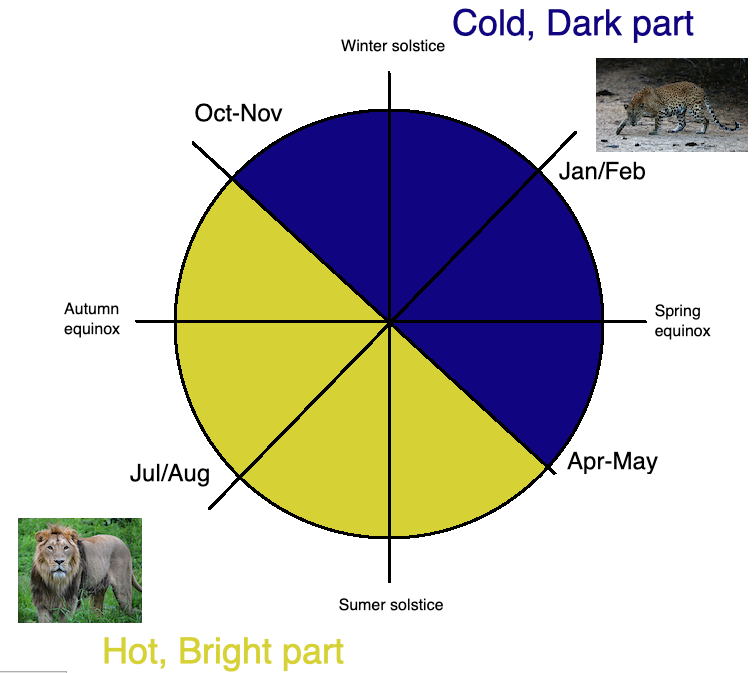
Why are fishes there? Well, it is possible that some migratory fish, which lived in the rivers flowing through the territory where the artist that made this object lived, migrated up the river „after autumn and winter”, which is why the fishes are depicted following the other animals??? That this is indeed the case becomes clear when we see the next object.
Dlaczego tam są ryby? Cóż, możliwe jest, że niektóre ryby wędrowne, które żyły w rzekach przepływających przez terytorium, na którym mieszkał artysta, który wykonał ten obiekt, migrowały w górę rzeki „po jesieni i zimie”, dlatego ryby są przedstawiane z innymi zwierzętami ??? To, że rzeczywiście tak jest, staje się jasne, gdy widzimy następny obiekt.
Fish shaped plaque.
Tabliczka w kształcie ryby
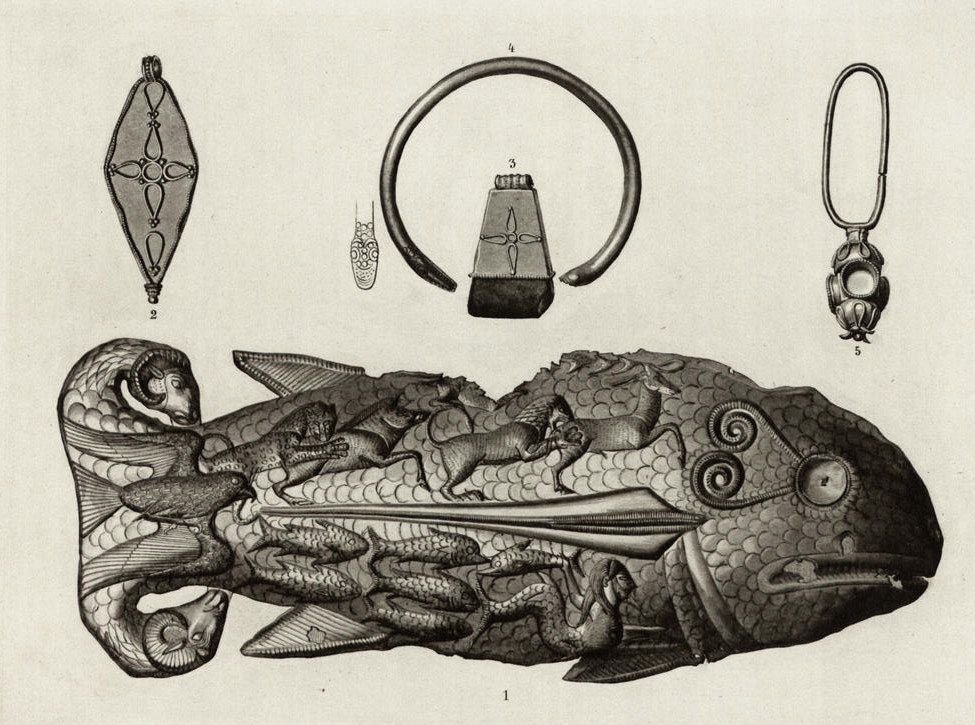
In the top strip on the fish’s body, we find the same two pairs of animals we find on the dagger sheath cover. From the head: lion chasing deer (autumn), leopard chasing boar (winter).
W górnym pasku na ciele ryby znajdziemy te same dwie pary zwierząt, które znajdziemy na osłonie pochwy sztyletu. Z głowy: lew goniący jelenia (jesień), lampart goniący dzika (zima).
In the bottom strip on the fish’s body, we find fish, fish, fish…Lots of fish swimming together. And dolphins…And a fish man…Strange things for steppe nomads to be into, right? But not for people living around the Black and Azov seas and along the great rivers that empty into them.
W dolnym pasku na ciele ryby znajdziemy ryby, ryby, ryby… Dużo ryb pływających razem. I delfiny… I rybak… Dziwne rzeczy dla stepowych nomadów, prawda? Ale nie dla ludzi żyjących wokół mórz Czarnego i Azowskiego oraz wzdłuż wielkich rzek, które do nich wpadają.
Like Greek colonists from many Greek cities dotting the Scythian coast…And they were into fish and fishing. And dolphins. And probably the fish guys (any idea who he could be?).
Jak greccy koloniści z wielu greckich miast rozsianych po scytyjskim wybrzeżu… interesujący się rybami i rybołówstwem. I delfiny. I prawdopodobnie faceci od ryb (jakiś pomysł, kim on może być?).
[CB – Niekoniecznie musieli to być greccy koloniści, mogła to być ludność znana już Herodotowi – Scyci Oracze – czyli Słowianie ROLNICY – CB]
This is why I believe that these gold objects were made in one of these cities, by a Greek…
Dlatego uważam, że te złote przedmioty zostały wykonane w jednym z tych miast przez Greka…
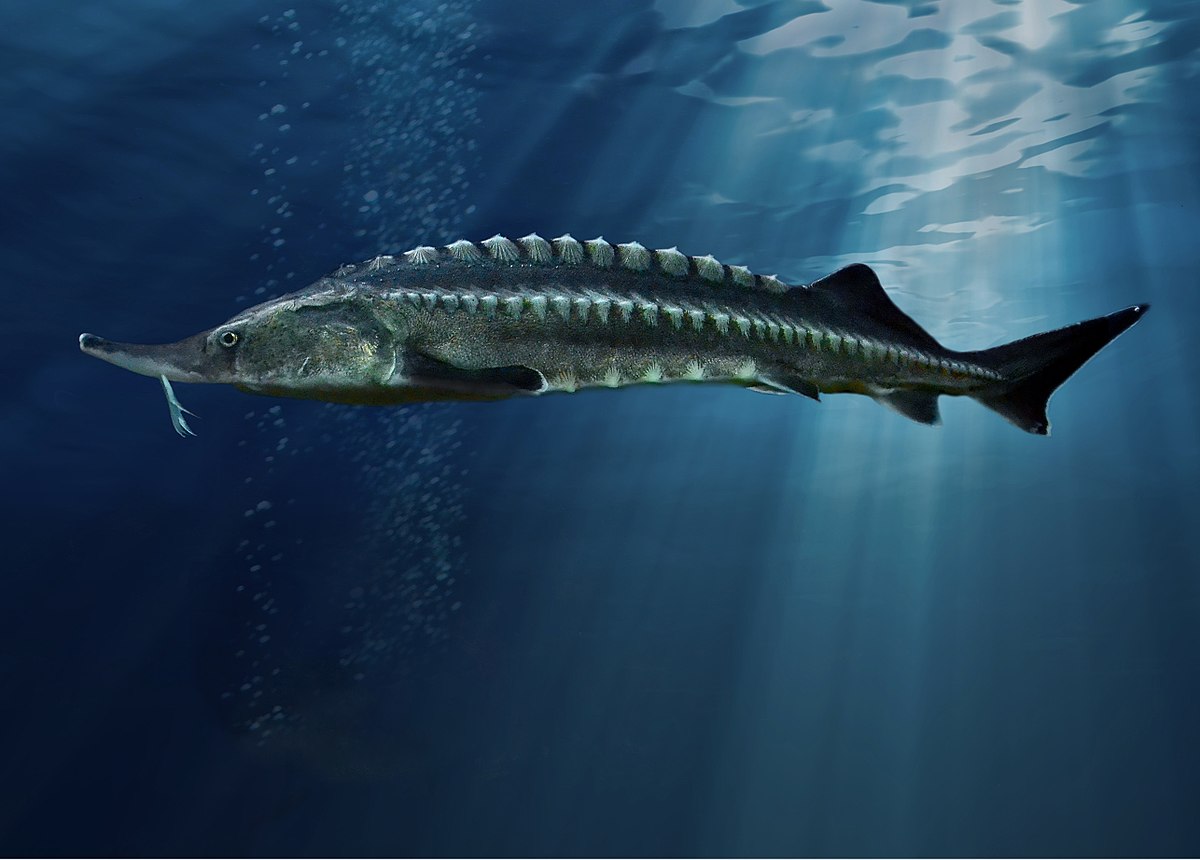
The tail is made up of two ram heads and a bird in flight. Ram is usually used as a symbol for spring (Feb/Mar/Apr). You can read more about the symbols of the seasons in my post „Symbols of the seasons”
Ogon składa się z dwóch baranich głów i ptaka w locie. Baran jest zwykle używany jako symbol wiosny (luty/mar/kwiecień). Więcej o symbolach pór roku przeczytasz w moim poście „Symbole pór roku”
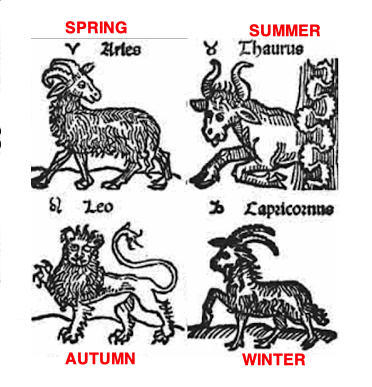
The lambing season of the wild Eurasian sheep takes place in (Mar/Apr). I talked about this in my post „Ram and bull„. The end of the lambing season is the beginning of the milking season. This important event is marked by Aries (Mar/Apr), which has to die in order for Taurus (Apr/May) to begin…Which is why we sacrifice lambs at this time of the year…I talked about this in my post „Aries must die„…
Sezon wykotów dzikich owiec euroazjatyckich ma miejsce w (mar/kwiecień). Mówiłem o tym w moim poście „Baran i byk”. Koniec sezonu kocenia to początek sezonu udojowego. To ważne wydarzenie jest oznaczone przez Barana (marzec/kwiecień), który musi umrzeć, aby Byk (kwiecień/maj) mógł się rozpocząć… Dlatego składamy w ofierze jagnięta o tej porze roku… Mówiłem o tym w moim poście „Baran musi umrzeć”…
So why are these ram heads here? Well, they represent spring (Feb/Mar/Apr) which follows winter, represented by leopard killing boar (Nov/Dec/Jan), which follows autumn, represented by lion killing deer (Aug/Sep/Oct)…More specifically, they represent Aries (Mar/Apr) which follows Pisces (Feb/Mar)…
Więc dlaczego te głowy baranów są tutaj? Cóż, reprezentują wiosnę (luty/mar/kwiecień), która następuje po zimie, reprezentowanej przez lamparta zabijającego dzika (listopad/grudzień/sty), która następuje po jesieni, reprezentowanej przez lwa zabijającego jelenie (sierpień/wrzesień/październik)… Dokładniej , reprezentują Barana (mar/kwiecień), który następuje po Rybach (luty/marzec)…
What about the bird? What kind of bird is it? It looks like a raptor. Is it possible that this is some kind of migratory raptor that arrives back to the steppe in spring? Or nests in spring?
A co z ptakiem? Co to za ptak? Wygląda jak drapieżnik. Czy to możliwe, że jest to jakiś drapieżnik wędrowny, który wiosną powraca na step? Albo gniazduje na wiosnę?
Interestingly, there is an eagle that nests in Mar/Apr and which fishes during the warm part of the year. And even eats dolphins (dead, stranded ones to be fair). White tailed eagle which lives along the Black and Azov sea coast…
Co ciekawe, w marcu/kwietniu gniazduje orzeł, który łowi ryby w ciepłych porach roku. A nawet zjada delfiny (martwe, osierocone, żeby być sprawiedliwym). Orzeł bielik, który żyje wzdłuż wybrzeża Morza Czarnego i Azowskiego…
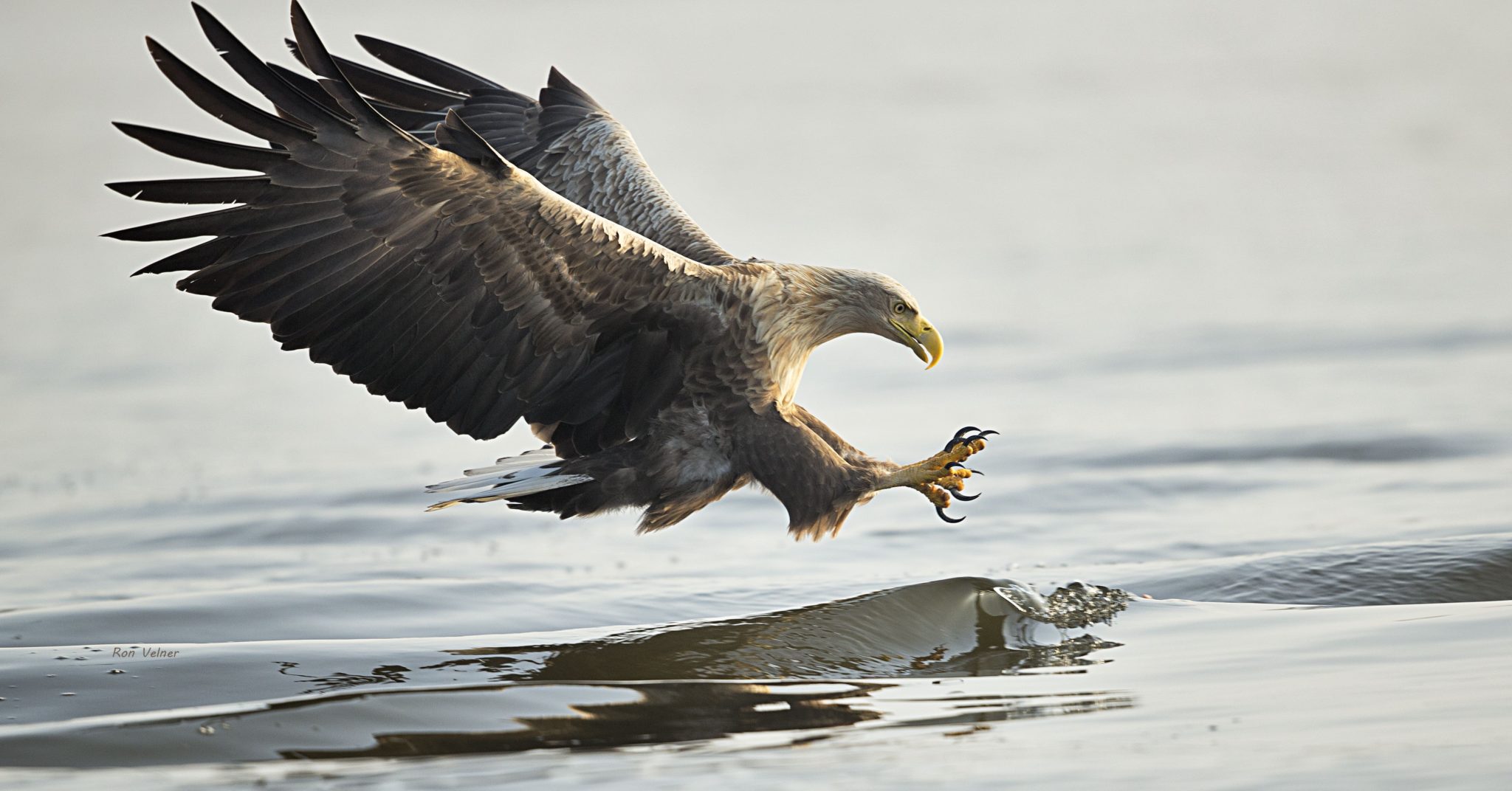
And Pontic Greeks depicted it on their coins both
eating fish
A Grecy Pontyjscy przedstawili to na swoich monetach zarówno
jedzenie ryby
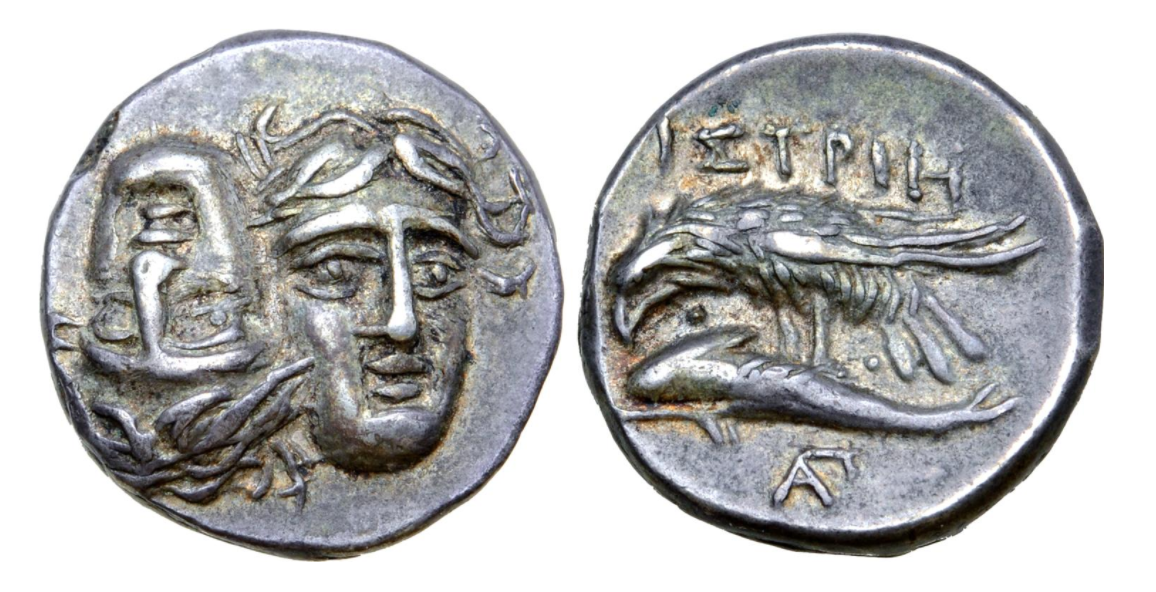
and eating dolphins
i jedzenie delfina
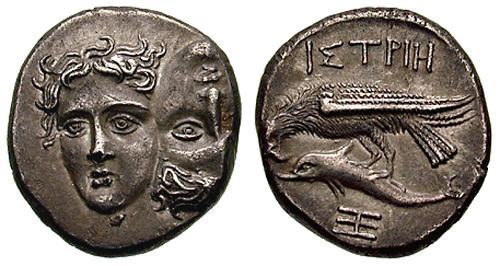
I talked about this in my post „Eagle eating dolphin„…
Cool, right?
Mówiłem o tym w poście „Orzeł jedzący delfina”… Fajnie, prawda?
The discs.
Dyski.
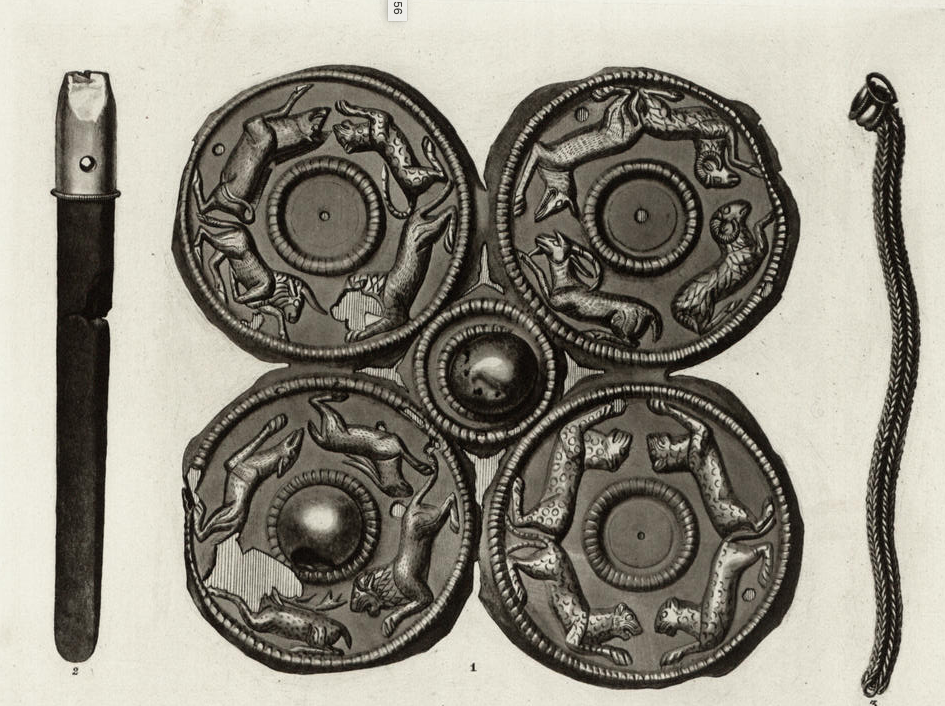
Top left, boar facing leopard (we have seen this already here, end of winter), and lion facing bull (we haven’t seen this here so far, but it represents the end of summer)…
U góry po lewej, dzik w obliczu lamparta (to już widzieliśmy, koniec zimy) i lwa w obliczu byka (do tej pory tego nie widzieliśmy, ale oznacza koniec lata)…
Summer (May/Jun/Jul) starts in Taurus (Apr/May). Taurus, which marks the beginning of the calving season of the Eurasian wild cattle. I talked about this in my post „Ram and bull„. This makes bull the most common symbol for the beginning of summer and the summer itself. I talked about this in my posts „Symbols of the seasons„, „Green pastures„, „Rain and flood„, „Dairy farming seal„, „But chewing„, „Holy cow„, „White calf„…
Lato (maj/czerwiec/lip) zaczyna się w Byku (kwiecień/maj). Byk, który wyznacza początek sezonu wycielenia dzikiego bydła euroazjatyckiego. Mówiłem o tym w moim poście „Baran i byk”. To sprawia, że byk jest najczęstszym symbolem początku lata i samego lata. Mówiłam o tym w moich postach „Symbole pór roku”, „Zielone pastwiska”, „Deszcz i powódź”, „Mleczna foka”, „Ale żucie”, „Święta krowa”, „Białe cielę”…
Here we could be looking again at the depiction of winter vs summer: coldest part of the year (Jan/Feb, wild boar and leopard mating season) and hottest part of the year (Jul/Aug, wild cattle and lion mating season)…
Tutaj możemy ponownie przyjrzeć się przedstawieniu zimy i lata: najzimniejsza część roku (styczeń/luty, okres godowy dzików i lampartów) i najgorętsza część roku (lipiec/sierpień, okres godowy dzikiego bydła i lwów). …
Top right, wolf facing ibex goat, and two rams facing each other…
U góry po prawej, wilk naprzeciw koziorożca i dwa barany naprzeciw siebie…
Ibex goats mate during winter (Nov/Dec/Jan) and just like wild boar are common symbol for winter. Actually the most common symbol for winter. I talked about Ibex symbolism in my posts „Combs from Tuva„, „Goat riding thunder god„, „Krampus” „Goat petroglyphs from Iran„, „Tanngnjostr and Tanngrisnir„…
Kozy koziorożców kojarzą się w okresie zimowym (listopad/grudzień/styczeń) i podobnie jak dzik są powszechnym symbolem zimy. Właściwie najczęstszy symbol zimy. O symbolice koziorożca pisałem w moich postach „Grzebienie z Tuwy”, „Kozły bóg piorunów”, „Krampus” „Kozie petroglify z Iranu”, „Tanngnjostr i Tanngrisnir”…
Wolves mate in Jan/Feb/Mar, at the end of winter. Which makes them a very good symbol for the end of winter and winter itself. I talked about this in my post „Tasmola talisman”
Wilki kojarzą się w styczniu/luty/mar pod koniec zimy. Co czyni je bardzo dobrym symbolem końca zimy i samej zimy. Mówiłem o tym w moim poście „Talizman Tasmoli”
So that part depicts winter.
Więc ta część przedstawia zimę.
What about two rams? This can either be the mating season of the wild sheep (Nov-Jan) or lambing season of the wild sheep (Mar/Apr)…I am not sure…Most likely spring…
A co z dwoma baranami? Może to być okres godowy dzikich owiec (listopad-styczeń) lub sezon wykotów dzikich owiec (marzec/kwiecień)… Nie jestem pewien… Najprawdopodobniej wiosna…
Bottom left. Dog chasing hare. The hare mating period starts end of January, beginning of February. I talked about this in my post „Winter spirit„. Hare is one of the most common symbols of spring…
Na dole po lewej. Pies goni zająca. Okres godów zająca rozpoczyna się pod koniec stycznia, na początku lutego. Mówiłem o tym w moim poście „Zimowy duch”. Zając to jeden z najczęstszych symboli wiosny…
The mating season of hares ends at the end of July, beginning of August…Right when the mating season of the old primitive dog breeds starts, in dog days…I talked about this in my post „Dog days„…
Okres godowy zajęcy kończy się pod koniec lipca, na początku sierpnia… Właśnie wtedy, gdy zaczyna się okres godowy starych, prymitywnych ras psów, w psie dni… Mówiłam o tym w moim poście „Psie dni”. .
Which is also when the mating season of both Persian fallow deer and Eurasian lions starts…I talked about this in my post „Entemena vase„…
Wtedy też zaczyna się okres godowy zarówno perskich danieli, jak i lwów euroazjatyckich… Mówiłem o tym w moim poście „Waza Entemena”…
So both dog/hare and lion/deer point to the same time of the year, beginning of Aug…
Tak więc zarówno pies/zając, jak i lew/jeleń wskazują na tę samą porę roku, początek sierpnia…
Bottom right…Four leopards facing each other…I have no idea what this could be. Maybe whoever made this object just liked leopards very much 🙂 Or maybe they loved sturgeon fish very much, which start migrating upstream (when it is the best time to catch it), in Feb/Mar, right after leopards finish their mating season in Jan/Feb…
Na dole po prawej…Cztery lamparty naprzeciw siebie…Nie mam pojęcia, co to może być. Może ktokolwiek wykonał ten przedmiot, po prostu bardzo lubił lamparty 🙂 A może bardzo pokochali jesiotry, które zaczynają migrować w górę rzeki (kiedy jest najlepszy czas na ich łowienie), w lutym/mar, zaraz po zakończeniu sezonu godowego lampartów w styczniu /lut..
That is not really that important…
To nie jest takie ważne…
Important thing is that these objects were not decorated with a random depictions of animals. Whoever made these objects used the same old animal calendar markers in the same way all the ancient cultures used them to create their „religions”…
Ważną rzeczą jest że przedmioty te nie były ozdobione przypadkowymi przedstawieniami zwierząt. Ktokolwiek wykonał te przedmioty, używał tych samych starych znaczników kalendarza zwierzęcego w taki sam sposób, w jaki wszystkie starożytne kultury używały ich do tworzenia swoich „religii”…
źródło: https://oldeuropeanculture.blogspot.com/2021/10/vettersfelde-treasure.html
